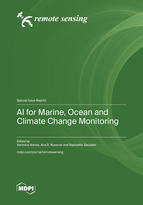AI for Marine, Ocean and Climate Change Monitoring
A special issue of Remote Sensing (ISSN 2072-4292). This special issue belongs to the section "AI Remote Sensing".
Deadline for manuscript submissions: closed (15 June 2023) | Viewed by 28944
Special Issue Editors
Interests: physical oceanography and global climate change via artificial intelligence; observation and integrated Earth-system modeling
Interests: ocean colour; machine learning; SNAP
Special Issues, Collections and Topics in MDPI journals
Special Issue Information
Dear Colleagues,
The oceans’ huge ability to absorb excess heat has important implications for the Earth's climate system. Higher sea levels, changes in ocean circulation and ocean biogeochemistry are some of the major consequences of ocean warming and melting glaciers. Due to complex feedbacks and climate connections, there is a growing interest in observing these ocean processes from space and modeling them by integrating new advanced statistical/machine learning and AI techniques, which may aid in the identification and prediction of such mechanisms.
Within this context, we invite submissions focusing on the skillful analysis and prediction of ocean-related processes through artificial neural networks and other machine learning approaches or their combination in hybrid dynamical–statistical methods. Contributions on remote sensing and modeling approaches designed to improve forecasting across various temporal scales and understanding sources of uncertainty/error in the model predictions are also welcome.
This Special Issue includes, but is not limited to, the following topics of interest:
- Global and regional climate change monitoring;
- Remote sensing and modeling of the oceans;
- Data-driven and machine learning algorithms;
- Data analysis, explainability, and prediction methods;
- Process-based modeling, integration, and fusion.
Dr. Veronica Nieves
Dr. Ana B. Ruescas
Dr. Raphaëlle Sauzède
Guest Editors
Manuscript Submission Information
Manuscripts should be submitted online at www.mdpi.com by registering and logging in to this website. Once you are registered, click here to go to the submission form. Manuscripts can be submitted until the deadline. All submissions that pass pre-check are peer-reviewed. Accepted papers will be published continuously in the journal (as soon as accepted) and will be listed together on the special issue website. Research articles, review articles as well as short communications are invited. For planned papers, a title and short abstract (about 100 words) can be sent to the Editorial Office for announcement on this website.
Submitted manuscripts should not have been published previously, nor be under consideration for publication elsewhere (except conference proceedings papers). All manuscripts are thoroughly refereed through a single-blind peer-review process. A guide for authors and other relevant information for submission of manuscripts is available on the Instructions for Authors page. Remote Sensing is an international peer-reviewed open access semimonthly journal published by MDPI.
Please visit the Instructions for Authors page before submitting a manuscript. The Article Processing Charge (APC) for publication in this open access journal is 2700 CHF (Swiss Francs). Submitted papers should be well formatted and use good English. Authors may use MDPI's English editing service prior to publication or during author revisions.
Keywords
- machine learning and hybrid models
- ocean remote sensing techniques
- climate change and feedbacks
- physical oceanography
- marine biogeochemistry







